Australian Aviation Barrister
Home | Articles | Events Flying | Video Clips | About | Contact
Private flying in the United States - Eight States in three weeks:
Published November 2010
On Wednesday, 16 September 2009 a group of four Australians and an American FAA instructor took off from the San Carlos airport in San Francisco. We were in a Cessna 206F. The instructor was on board to check me out for my FAA biennial. This article is about our flight across to Houston via Salt Lake City, Lake Powell, Monument Valley, The Grand Canyon, Vegas and back to San Francisco. As 206s go, this one was a special: a powerfully great climber – a quality not missed where we were flying. Flying privately as a visitor to the States is achievable with some timely planning.
Some days earlier I had met with an FAA Official across The Bay in nearby Oakland. This was to attend an interview and to check my paper work to obtain my FAA Airman’s licence. This process should not be lightly dismissed as a bureaucratic step. Applications for an FAA licence must be filed three months before this interview. At that time of three months in advance, one must nominate the FAA office from which you want to do the interview and if successful collect your licence. Before all this you need to pay CASA to send over to the FAA your licence verification. Locating the office for the interview was something of a challenge. It probably would have helped if the taxi had been equipped with a GPS street directory.
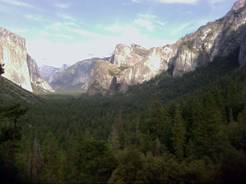

(1) Yosemite National Park
During our first day in SF we hired a push bike each from Fisherman’s Wharf and rode over the Golden Gate to return from Sausalito by ferry, well worthwhile. The following day we drove up to Yosemite National Park, across to Carson City and Virginia City all taking a few days.
Our 206 was based in Salt Lake City (Utah). I was told when hiring an aircraft in the States one must pay for a number of hours per day whether you use them or not. Also, if only VFR and the weather grounds the aircraft, you still pay. We were required to pay for three hours a day, rain, hail or shine. 206s are not plentiful to hire in the States and are considered a high performance aircraft. There are many more 182s to hire. The plane was flown over to SF by my FAA Certified instructor, Eric Jeppsen. He was authorised to do my US Abiennial flight test and ground training. The aircraft was a bright yellow, an excellent colour for flying around the often snow covered mountains of Salt Lake City.
San Carlos is at an elevation of 5 feet, with the one runway 12/30. It has a Class D tower. Procedures for taxiing and take off were similar to Australia. During my first communications I was asking myself, if only they spoke Australian, it would be a breeze! I laugh when I imagine what the operators must have thought about my Australian accent!


(2) San Francisco International as we fly over.
Almost immediately after becoming airborne we were handed over to NorCal Control. We asked for a flight via the Golden Gate and then east for Reno(Nevada). We were directed smack over the middle of San Fran International Airport; at I think it was 2,000. It was interesting what ever the height was. It was low given San Carlosis only eight nautical miles south.

(3) Downtown San Francisco as we track for the Golden Gate
As is typical around The Golden Gate, the cold currents from the north had produced the usual fog. We were able to only grab glimpses of the Golden Gate Bridge. The weather was otherwise perfect, if a little warm.
Our track via Reno(Nevada) gave us a view of Lake Tahoe and avoided the higher peaks of the Sierra Nevada Ranges. As it was we were cruising at 11,500 feet. In the States aircraft stay on their altitude settings to 18,000 feet (10,000 feet in Australia). The next track was Lovelock (Nevada) and onto Battle Mountain(Nevada), where we landed for fuel. Battle Mountain is 4,532 feet. It was a hot day of over 80F. The mountains around Battle Mountain are not to be ignored. How often in Australia do we take off at 4,000 feet and then still have surrounding terrain over 3,000 feet above ground level? Fortunately there is a valley to exit through to the east. Whether it was the synergy between Lovelock I’m not sure, but I repeatedly managed to refer to Battle Mountain when transmitting to local traffic, as “Broke back Mountain!”

(4) Battle Mountain Airport looking east

(5) Just west of Salt Lake City
Our destination at Salt Lake was the so called South Valley Regional airport. It is the home base for the aircraft. The strip is 4,607 feet high with a unique circuit (they call it pattern) height of 5,407 (800 feet AGL) to avoid the B airspace of Salt Lake’s main airport. On our track from Battle Mountain we were cleared through a military flying training area. I don’t think I’ve come as close to a Hornet in the air as we did that afternoon. We were warned of their attendance, a factor which did not reduce the flow of adrenalin.
We spent a couple of nights at Salt Lake, doing the tourist type things including the Mormon Visitors Centre. Eric as you might expect is a Mormon and a very nice chap too.
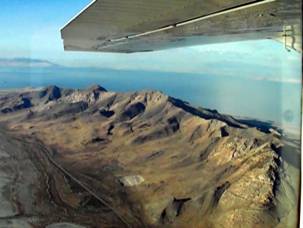
(6) Approaching the salt lake of Salt Lake City
At South Valley Regional I spent over an hour in ground training before my log book was given the required sticker for the biennial. The ground component of the training is an absolute must for any prospective first time Australian private pilot flying in the States.

(7) On final at South Valley Regional Airport approaching from the south
American VFR pilots work off Sectional Charts. They provide a larger scaled map than the good old WAC. The USA WAChas so much data that one spends hours crawling through it.
From South Valley Regional we tracked south to Spanish Fork then south east to the Canyon lands area, Utah. We intercepted the Green River following it down to the Colorado River and Lake Powell. This was probably the most spectacular flight I have done over an inland area. Absolute tiger country, but one is too busy looking at the huge and spectacular canyons to be concerned about the engine going quiet.

(8)The northern end of Canyon lands

(9)The Green River in Canyon lands

(10) The very northern end of Lake Powell

(11) Lake Powell
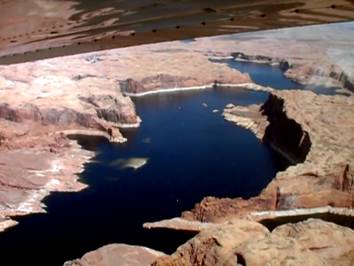
(12) Lake Powell
At a point level with Monument Valley (Utah) off to the east, we turned left over LakePowelland tracked for the valley. (I resolved to return to LakePowelland hire a house boat). Flying over the mesas around Monument Valley is interesting stuff. We flew adjacent to MonumentValley(see photos 14 & 15 of a mesa from the air and the ground). We landed at Cortez (Colorado). Cortez has a mountain over 9,900 feet just to its west, so we came a little south to get around it. The runway at Cortez is some 5,918 feet high. We stayed two nights. My companions drove to nearby Mesa Verde with its medieval Pueblo ruins carved into cliff faces. I’m told this is well worth while. On their return we drove into Monument Valley. I did not appreciate there is a Hotel with magnificent views over the mesas of Monument Valley. The Hotel is painted so as to blend into the country while perched on an escarpment with magnificent views. However, one can still see the cars (photo 14). Had I known, we would have probably stayed here. Driving through the valley one observes it to be unspoilt. Its isolation hopefully will preserve it as a special place.

(13)Approaching Monument Valley

(14)Close to Monument Valley

(15) A mesa – note the Hotel car park off to the right

(16) The Mesaon the left is the one shown above

(17) Western films director, John Ford’s favourite lookout
Once back in the air we flew to Albuquerque(New Mexico) for fuel thence Lubbock (Texas) for the night. Albuquerque is 5,355 feet high. While descending I left myself too high. It is a class C tower. I was given what we call a visual approach but I didn’t appreciate this, not having heard the words “visual approach”. When I enquired whether I could descend, the tower replied “descend at your discretion”. I had to request a couple of orbits to wash off some height. Fortunately I suspect it was a quiet day as I heard almost no other traffic.
Lubbock was merely a convenient spot to stop for the night and make our destination, Houston, achievable the next day. The Lubbock runway is 3,282 feet high. Lubbockis a university town and like Cortez, small for America. The airport is titled “Lubbock International.” The day we were there this title seemed over-specified. The staff at the FBO were very friendly.
This brings me to mention the FBOs. American airports generally have an FBO: A Fixed Base Operator. This operator looks after your plane attending to, refueling, oiling and parking. One leaves the aircraft brakes off so they can move it as required with a tug. If you buy their fuel (price varies between $4.50 and $6.20 a US gallon), there is generally no parking fee. The facilities at these places are a sight to behold, normally most luxurious. I could not help thinking these are something from busier times. The FBO will organise for a car to go right to the aircraft collecting baggage or they shuttle you over to their terminal with a truck or trailer. If there is a chance of a storm the plane is moved into a hangar. I have a real fear FBOs will disappear if America’s General Aviation does not pick up.
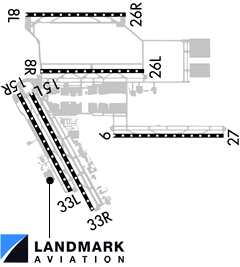
(18) George Bush International Airport Houston-Landmark was our FBO
We achieved an early than usual departure from Lubbock. We were flying into Houston to see the mighty Astros play a ball game. We tracked to Houstonvia Mineral Wells thence direct to George Bush. George Bush airport has five two way runways. I think it was about six frequency changes from first contact with Houston and shutting down the engine. The tower has three frequencies. The controller(s) direct your height and heading much the same as a primary control area in Australia. Another thing; in the US they sometimes use the third decimal point in their radio frequencies. One of our tower frequencies was 120.725. Busy, springs to mind when I recall flying into Houston’s George Bush airspace. The airport has an elevation of 97 feet, a pleasant change with no density altitude issues. The controllers were patient with my sometimes momentarily slower language recognition than the locals. It was hazy, humid and a bit smoggy that day with no wind. I did not really see the runway until the controller said “Turn right onto (a heading)” which I acknowledged, but then virtually immediately, I was “Clear to land Runway 26R.” The runway was ahead and just a bit off to my right.
As I was rolling clear of the runway and at speed, on the first of the high speed exit points, I heard another plane getting clearance to land on the same runway. To get across to the FBO, on the other side of this huge airport, we had at least three frequency changes. I remember waiting at the holding point to cross runway 8R, we were right on the landing end piano keys. On turning our heads to the right we saw aircraft stacked up on final. In front of the lowest aircraft, we were told to cross the runway. A dramatic call! I admit to an almost full power start to the taxi, followed by heavy braking on the other side. Another difference, you are told to go to a point and hold at that point to cross a runway, then monitor a new frequency. Out of the silence on the new frequency, one suddenly hears the controller telling you to cross the runway.
I remember flying into Mascot a couple of times before they put up their airport landing fee. Mascot was and would be now, a walk in the park compared to the large American airports we visited. The American controllers were friendly with no issues (or at least none which they showed) about a little old VFR 206 flying into their heavy jet territory. That said, my experience in Australia has been the same, friendly and no issues with VFR. However, I suspect we don’t in Australia, tolerate the same proximity with VFR traffic at major airports as they do in the States.
One of the best steaks in my life was consumed at Houston on that first night. It was a slightly up market restaurant which fortuitously also sold Australian red wines. While the Napa Valley and other Californian wines had been generally very good, a bottle of 2004 Bin 128 was too much to ignore at the reasonable price offered. I observed that the size of the American follows the size of their meal. An Entrée is the main course, with Starters being the Entrée. One of us ordered two so called Entrees rather than a Main. Or so he thought. The waiter said “That’s sure a lot food but then you are a big man.” That was when we learnt about the American Entrée.
The next day we drove down to the Houston Space Centre. That night we met our host for the ball game, a local attorney. We ate at a steakhouse, then watched the local mighty Astros go sadly down to the Cardinals. It is a real night out! The stadium had its own steam train engine which blew its whistle and moved forward if the Astros hit a home run. They play three games over a week. The team, owned by a local food distributor, lost that night, but won a couple of nights later, then lost the final game of the week.
Given the weather was everything but VFR we drove to New Orleans. It’s a five and a half hour drive flat out. We drove under an almighty thunderstorm stopping the vehicles on Route 10. Driving around we found accommodation in the French Quarter, walking distance from all the haunts. Great food was available in the Quarter, along with very late nights in little bars with their live music. The Quarter was spared from damage by hurricane Katrina.
Back to Houston after two nights in New Orleans, to stay about a 45 minute drive from George Bush in a little town called Dayton. The next morning breakfast included a make your own waffle at the waffle machine, with maple syrup of course.
The 206 was waiting ready to go. The FBO drove us and our gear out onto the tarmac. I had completed my flight plan at the Motel. Like Australia, the States have a number to ring to get the weather and Notams (1-800992-7433). As you depart from your first airport on a day’s flying, you can request “flight following.” This done, controllers look after you most of the way handing you over to the next sector and organising clearances as required and all without filing a plan. An excellent system which I recommend to non familiar Australian pilots. One of the controllers had a sense of humour. I was being handed over to the next frequency and the controller signed off with “Have a good day mate!”
Departing George Bush was simple. A clearance obtained from clearance delivery, we taxied up to the left to the end of the runway immediately in front of us, 15R. Becoming airborne we were turned to the west for our next tracking point, Austin. We flew directly over Austin and onto San Angelo (Texas) before landing at Midland (Texas), where George W Bush once lived.

(19) A West Texasoil field
The oil fields of Texas occupied our view for much of the flight from Houston. Once at Midland Airport(2,871 feet high) we hired a vehicle to find a Motel in the twin town Odessa. Though we had a GPS in the car, we still had some trouble finding a Motel. We certainly saw Odess awhile looking for a Motel! Having moved into our rooms we went to our first Hooters Bar. This is an establishment staffed by well built young women working in loud music. The others in the group had not experienced Hooters just as none of those Hooters staff we saw that night had experienced Australians. Eventually we were able to place an order. The accent was not easy both ways. She said in her slowest Texan “Three beers and a white wine coming up.” Confirmation of the order was possible only after long discussion about which beers and as to what a white wine was. The white wine was a brave choice by Jim given we were not confident that the order was understood. Three beers arrived in pint sized glasses with a handle, as too did the white wine but with ice and a slice of lime in the same type of glass. I suspect Jim must have gone into shock. He refused to even try it. Too Texas big was the wine and music for Jim that night.
The next day was The Grand Canyon. Not able to fly there non-stop we landed at Winslow, Arizona. It was a hot day. Winslow is 4,941 feet. We were at a density altitude of about 7,000 feet. The track to Winslow was not direct.
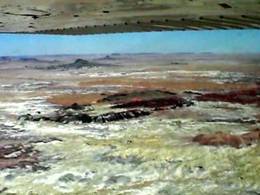
(20) Painted Desert
Painted Desert required an inspection. If you have the time, do it. It is north east of Winslow and clearly marked on the relevant Sectional Map. The track to the Painted Desert from Midland was via Roswell(New Mexico), Socorro (New Mexico) and St Johns Industrial (Arizona). The leg Roswell- Socorro involved dodging some active military areas and some mountains over 10,000 feet. Indeed a scenic flight. These mountains stand out from their flat surroundings.
At Winslow there was a group of aviators on a fly-in using post WW-II Swift’s. One Swift passenger commented on her needing to wear a wide hat and industrial strength sunscreen, she envied the high wing of the 206 with its shade. Without them, I doubt we could have worked the credit card self-serve fuel bowser. It was no ordinary self service pump!
After filling the plane with fuel to avoid the necessity of taking fuel at Grand Canyon (where I wanted to stay as light as possible), we lined up on runway 29. We had landed on runway 4 but there was no wind so we moved to the closer 29. It was a long run down that hot sealed runway, somewhat reminiscent of taking off to the north at Birdsville on runway 32.

(21) The Barringer Crater, observe the mountain on the horizon

(22) The Barringer Crater
The Barringer Crater, or as it is simply shown on the maps, ‘meteor crater’, is about 20 miles due west of Winslow. This is worth a look. As one flies over it the force of the meteor strike becomes obvious. The settlement on the northern edge gives the hole a depth and width.
After circling the crater we tracked northwest for Grand Canyon Airport. A very spectacular flight. Just off to our left was a mountain 8,938 feet and very visible further to the left was a mountain 12,633 feet (seen in photo 20). We also flew over what appeared to be a recent volcano. Fortunately there was no wind so we didn’t suffer mechanical turbulence.

(23) A recent volcano (?) between the Barringer Crater and The Grand Canyon
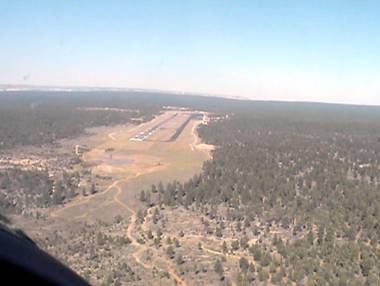
(24) The Grand Canyon Airport looking north.
The cliffs of the northern rim are just visible top left.
At this time of the year Grand Canyon (Arizona) has a D tower. The runway is on the southern side of the canyon. The runway is at 6,609 feet. It was a hot day with our density altitude a fraction under 9,000 feet. Arriving mid to late afternoon did not assist. We were well looked after by the equivalent of their FBO. There is a small fee for parking overnight. Importantly we were able to purchase the special flight rules area map. Condors are at home in the Canyon area. There are therefore set tracks required when flying over the Canyon. Approaching as we did from the south for a landing meant we were not going into the special area. In any event I was kindly given an old map by one of the group at Winslow. I bought a new one at the airport on arrival.
When staying at the Canyon, while it might be a little more expensive, I recommend staying in the actual National Park on the rim rather than the village as we did. Hire cars are not available. There is a taxi service of types. All the fees are fixed. If there is a group of you it’s not too bad. To be able to walk out to the edge of the Canyon whenever you felt like it would be pleasant. A couple of us took a trip on a helicopter over the Canyon and the other two walked partly down into the Canyon. It was a really lovely day, still if also warm. There is a free bus service along a road to the west from the park accommodation along the rim. Be careful, the bus will not stop at the points it drops you. No one told us this. We took a bus a fair way along the rim to then walk back along the rim hoping to be able to pick up a bus when we had had enough. They all drove past, except for one kind driver as we were resigning ourselves to a walk back in the dark. There are specific return pick up points, walk to one and wait. Another thing about the Canyon: There is a thin sealed pedestrian track along the edge of the rim and I mean edge. One is reminded that America is the land of the free. If you are casual enough to not watch your step, you are free to fall off the rim. There is no safety rail.
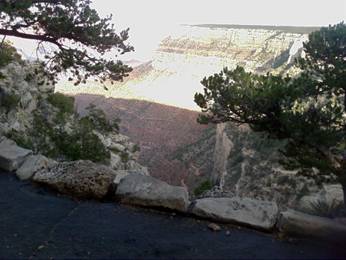
(25) The land of the free
Two nights at the Grand Canyon then on to Las Vegas(Nevada). Taking off in the cool of the morning was appreciated by all. We had little trouble getting airborne along the 8,999 foot runway. North of the airport there are five areas where flights below 14,500 feet are not permitted. GPS positions to fly between ensure you remain in corridors to avoid these areas. North bound traffic flies at 11,500 feet while southern at 10,500 feet.

The Grand Canyon from the helicopter
So one is a good few thousand feet above the rim, not to mention the Colorado River thousands of feet below. It was a most interesting flight. The Canyon is truly huge! I put 10 degrees of flap out and flew a slow cruise over the Canyon, in straight lines to the designated way points. We saw several condors from the ground but none from the air.

(26) Short final McCarran Las Vegas – note the pyramid (Luxor Casino)
Our track to Vegas took us over Lake Mead. The Hoover Dam was off to our left but too far to be convenient for our approach to McCarran International. This is another Class B airport. We were most effectively vectored down to runway 19R which is at 2181 feet. The FBO was fantastic. They guided us to a parking spot and drove us back to their base. They then dropped us off at our Casino, The Flamingo. It was $45.00 US a night for a huge comfortable room. We decided to treat ourselves, we took a room each.
Our first night in Vegas saw us at a show with a band called “Human Nature”. Sure they were Australian but they were good. The show was excellent. They sang only well known Motown songs and did so very well! The setup of the audience was near perfect. We sat at tables longitudinally pointing to the stage. The bar service was adequate keeping us on a fine Californian Sauvignon Blanc. The next day we walked the strip and Casinos. Beyond description is how I describe it! Some of us went into the Titanic Exhibition installed in the Luxor Casino. Worthwhile and quite moving. That night we went to another show “The Fab Four.” These boys were as near to the real thing as I have seen live. They changed costumes very quickly. Ed Sullivan himself was back from the dead to host the show. Brilliant!
Not a late start saw us airborne off the same runway in the opposite direction. Our FBO’s premises (Atlantic) at McCarran was wonderfully luxurious with helpful staff (not unlike most FBOs).
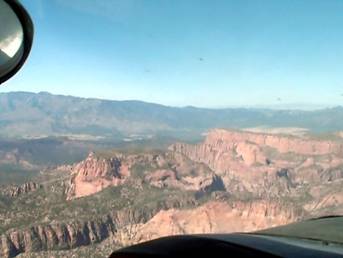
(27) Zion National Park
This day’s flight commenced with the intention of flying back to Salt Lake City via the Zion National Park(Utah). We basically followed Route 15 to St George (Utah) and then tracked on to the National Park. After the park we flew over Cedar City and back to South Valley Regional via Provo(Utah). As we approached Salt Lake the snow which fell while we were away was evident. It was a spectacular scene as we flew up the side of the mountains to South Valley Regional.
The plan was to fly commercially back to San Francisco that night and stay the night there before flying home the next night. We discovered it’s not possible to book a flight on a computer if your card is not based in the States. Rather than take a long taxi ride to the main Salt Lake Airport not knowing if we would get on a plane, we decided to fly ourselves to SF.

(28) Looking east towards the Rockies east of Salt Lake

(29) Nearing Salt Lake on our return

(30) Approaching south of Salt Lake City
The same instructor Eric came with us to bring the machine back home. He was instrument rated so we had no issues with last light. The weather was perfect for a non stop flight, for this time, San Francisco International. We landed around 9.30pm local time behind an A-300. We left the plane at the FBO which was surprisingly expensive compared to the other FBO’s we visited.
We returned to the same Hotel we had stayed at on our arrival, ordering in pizzas. A feeling of familiar territory greeted us as we walked to the convenience store to greet the same individual seen a couple of weeks earlier. The next day we had a lovely lunch at “Scoma’s” at Fishermen’s Wharf. No bookings are taken. You register as you walk in, sit at the bar with a beer, watch the locals and wait to be called. A relaxing day was had in SF before a taxi to the airport that night.
Those interested in flying in the States can get their maps etc at http://sportys.com/PilotShop (They take a couple of weeks). Also see www.airnav.com for details on airports. The USAis very State orientated. Airports are listed under their state rather than alphabetically. Go to the FAA website to get the details of what you are required to do.
See - https://www.faa.gov/licenses_certificates/airmen_certification/foreign_license_verification also, don’t hesitate to call me 02-62575255.
Chris McKeown
© C. McKeown 2010.